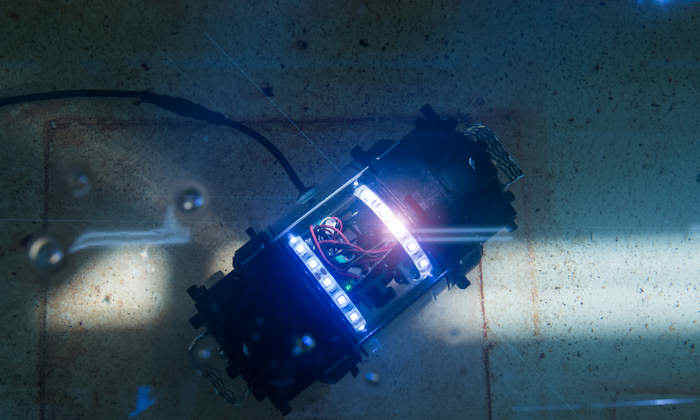Robots to the rescue
07 Sep 2016
Creating an electronic eye for Fukushima – and beyond

Cleaning up radioactive waste is a dangerous job for a human. That’s why researchers at Manchester are developing robots that could do the job for us.
Five years ago, in 2011, a major earthquake and tsunami devastated the east coast of Japan, leading to explosions and subsequent radiation release at the Fukushima Daiichi Nuclear Power Station. The fuel in three of the reactors is believed to have melted, causing a large amount of contaminated water on site.
This is still to be dealt with today – which isn’t too surprising, given that the clean-up of Chernobyl is still underway 30 years after the infamous nuclear accident took place.
Dangers to life
After the accident at Chernobyl, where an extremely high level of radiation was released, workers had to be sent into areas to which you wouldn’t want to send a human being. For the safety of others, they entered the plant to survey its condition, extinguish fires and manually operate equipment and machinery – all in an environment that endangered their lives.
The challenge in dismantling the site at Fukushima is the residual radiation level. In the surrounding areas levels have fallen significantly; in some places (still off limits to former residents) radiation levels actually aren’t very different from natural background levels in certain other parts of the world. But in the reactor itself a person would receive a lethal dose of radiation almost instantly.
“At Fukushima, many of the instrumentation systems, such as reactor-water level and reactor pressure, were lost in the incident. This made assessing the integrity of the plant extremely difficult as you couldn’t send people to go and look at it,” explains Professor Barry Lennox, who, alongside Dr Simon Watson here at the University, is working to find another way of getting access to such dangerous places: by using robots.
A robotic solution
Professor Lennox and Dr Watson are part of a team working to adapt robots to help clean up Fukushima. They’re developing an underwater remote-operated vehicle – the AVEXIS – to help identify highly radioactive nuclear fuel that is believed to be dispersed underwater in the damaged reactor. The robot is already aiding decommissioning efforts at Sellafield, where it will swim around the ponds storing legacy waste to map and monitor the conditions within them.
“Getting the robot to survive the radiation is the primary challenge at Fukushima. A person couldn’t survive inside the reactor, nor can certain electronic parts,” says Professor Lennox. “The semiconductors in the robot could be damaged so we need to test how long they last in a radioactive environment.”
The Dalton Nuclear Institute’s Cumbrian Facility, the University’s off-campus, state-of-the-art nuclear research centre, has just the equipment for this. Its Cobalt-60 gamma irradiator allows Barry and his team to test the stamina of their creations in conditions similar to the Fukushima reactor.
Professor Lennox continues: “We need to make the robot very small so it can enter the reactor through a 115mm hole drilled through metre-thick concrete. Once it’s in, it needs to be able to see – feeding visuals back to us to navigate – swim, detect radiation levels and its own position, and survive for a ten-hour shift. It also needs to be relatively cheap as once it’s gone in, it isn’t coming back out.”
The final product will be a group effort, with colleagues at Lancaster University designing a tiny neutron detector and Japanese partners providing an equally tiny sonar system.
Building the bigger picture
Once inside, the three elements will come together to build a map. The neutron detector will indicate from where radiation is originating and the sonar system will show the geographical layout.
Putting these together, a picture can be built showing where the fuel is, allowing decommissioning to move to the next level. Removing and safely storing the fuel will then significantly reduce radiation levels, which in turn will make the remaining decommissioning process safer and cheaper.
Professor Lennox believes robots have a lot of potential. “They could have been the first responders at Fukushima – checking areas for safety before any humans came near,” he notes.
“They have a huge role to play in decommissioning, which now has to be built into any new nuclear plan from the start.
“We’re also working on robots that can travel along pipes to check for corrosion inside, so they can contribute enormously to inspection too, keeping running reactors safe.”
